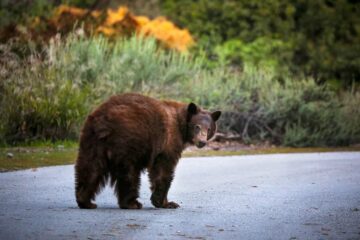Homeowners, developers blocking access to established trails
Gated communities and recreational users are fighting over the closure of pathways on private land in the Santa Monica Mountains.
Source of this article – Los Angeles Times, May 10, 2006.
By Jessica Garrison, Times Staff Writer

CLOSED OFF: Attorney Robert Garcia, right, and Tom Freeman are leading the fight to preserve access to recreational trails in the Santa Monica Mountains. (Lawrence K. Ho / LAT)
Long before developers built multimillion-dollar homes atop the ridges in the Santa Monica Mountains, hikers, horseback riders and bikers beat trails across the privately held land that affords stunning ocean views, effectively using the area as a giant park.
Though the chaparral just west of the 405 Freeway is giving way to exclusive gated communities, many recreational users contend they have the right to keep using the trails, especially because the trails connect to paths in the Santa Monica Mountains National Recreation Area.
Homeowners and developers say they are willing to provide access to well-established trails, but they do not always agree with trail users on which paths are established and what sort of access ought to be granted. The result has been a simmering dispute, punctuated by lawsuits.
Another round began this week, when the Center for Law in the Public Interest and two other groups filed a lawsuit demanding public access to what they are calling the Mount St. Mary’s Trail.
According to the lawsuit, the trail runs “north from behind Mount St. Mary’s College, along the Mount St. Mary’s Fire Road.” The suit says the trail is an established footway in use since at least the 1950s. The lawsuit also says that in August, a developer erected a locked metal gate across the trail and topped it with concertina wire, severing a connection to the Canyonback, Westridge and Sullivan Canyon trails and ultimately to the 20,000-acre “Big Wild” network in the Santa Monica Mountains.
The developer tells a different story.
“There is no official trail,” said Frans Bigelow, project manager for developer Castle & Cooke. “The trail they are calling the Mount St. Mary’s Trail is a fire road.” Bigelow said the road was closed in 1978 when the area was used as a landfill, not in August, as the lawsuit alleges. What happened in August, he said, was that the gate, which had been partially ripped out, was repaired. The Fire Department keeps keys for gates on fire roads and for gated communities.
Robert Garcia, a lawyer with the Center for Law in the Public Interest, said that it is “irrelevant” that the trail is a fire road.
“We have declarations from 20 people or more who have been using the trail back to 1950,” he said. “We have a declaration from a nun at Mount St. Mary’s.”
“This is part of an overall trend by which wealthy enclaves think they can simply take over public parks, public beaches, public trails,” he added. “We’re not going to allow it.”
Los Angeles City Councilman Bill Rosendahl, who represents the area, declined to comment on the dispute. Through a spokeswoman, he issued a statement: “We are working with all parties to try and find an amicable and mutually beneficial resolution to the issue and I’m hopeful that can be accomplished.”
But few on either side predict harmony soon.

FREEDOM FIGHTERS: Attorney Robert Garcia, left, and Tom Freeman are in the vanguard to keep hiking trails in the Santa Monica Mountains free from closed gates that would prevent access. (Lawrence K. Ho / LAT)
In February, the Canyonback Alliance filed a lawsuit accusing the city of Los Angeles of illegally allowing developers to erect gates on Stoney Hill Road in the Mountaingate development.
Frank Mateljan, a spokesman for Los Angeles City Atty. Rocky Delgadillo, said the road is not public and does not lead anywhere.
In other instances, however, the city has sided with recreational users seeking access to the land.
In 2004, the city attorney’s office refused to allow residents of “the Crown,” a 70-home community of multimillion-dollar houses atop a ridge overlooking the ocean and the Sepulveda Pass, to put a gate across Canyonback Road at Mountaingate Drive. The gate would have blocked vehicle traffic into the community.
Now, the pillars remain hinge-less, much to the annoyance of many in the neighborhood.
They say they are bothered by car alarms and dog excrement as dozens of people drive into their neighborhood to walk their dogs at the trail at the far end of the development. They also complain that teenagers on their way home from hiking have jumped the fence and used the homeowners’ association swimming pool. They are worried, they say, that a wayward cigarette could ignite the hillsides.
“For all these reasons, I’d like a gate,” said Lois Goldberg, who has lived in the area for nine years.
Sentiment in favor of the gates is so strong in the neighborhood that one woman who does not want them refused to give her name. “Do you want me to be hanged?” she asked.
Another battle is looming. Developer Castle & Cooke is hoping to break ground on seven new houses in an area bisected by a popular trail.
This time, the developer has agreed to keep access to the trail open by giving an easement in perpetuity that would allow hikers to pass through the development.
Access groups say that’s not good enough. They say that a few years from now, homeowners in the new development will be clamoring for a gate of their own, and they want the trail moved so it skirts the development.


